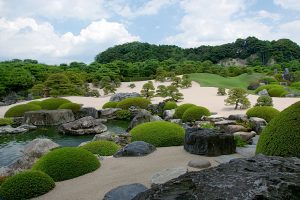Traditional Japanese Gardens are meant to be peaceful spaces, built around a specific set of rules. Gardens in Japan evolved into various styles, each with a different purpose. Strolling gardens for recreation, were popular among the lords of the Edo Period, while the dry stone gardens were used by Zen monks.
The artistic “natural” look was achieved through asymmetry and odd numbers. Great gardens can be found throughout Japan, here are six of them:
1. Kenroku-en, Kanazawa
 Often regarded as the most beautiful private garden in the country, Kenroku-en was built by the Kaga clan in the 1620s near Kanazawa Castle. Full of lovely streams, hills groves, pavilions, and bridges, it is one of the Three Great Gardens of Japan.
Often regarded as the most beautiful private garden in the country, Kenroku-en was built by the Kaga clan in the 1620s near Kanazawa Castle. Full of lovely streams, hills groves, pavilions, and bridges, it is one of the Three Great Gardens of Japan.
2. Ryoanji, Kyoto
 Perhaps the most famous Zen garden in the world, it is one of the finest surviving examples of kare-sansui (dry landscape). Built in 1450, the 15 mossy stones are set in swathes of smooth pebbles. Though the rock garden is the best known, the complex also houses a water garden, a teahouse, and tea garden.
Perhaps the most famous Zen garden in the world, it is one of the finest surviving examples of kare-sansui (dry landscape). Built in 1450, the 15 mossy stones are set in swathes of smooth pebbles. Though the rock garden is the best known, the complex also houses a water garden, a teahouse, and tea garden.
3. Kokedera, Kyoto
 Popularly known as Kokedera (moss temple), Saihōji is one of the many UNESCO World Heritage Sites in Kyoto. Known for its many different varieties of moss centered around the Golden Pond, entrance to this garden requires advance reservations.
Popularly known as Kokedera (moss temple), Saihōji is one of the many UNESCO World Heritage Sites in Kyoto. Known for its many different varieties of moss centered around the Golden Pond, entrance to this garden requires advance reservations.
4. Adachi Museum of Art, Yasugi
 The meticulously maintained gardens surrounding this museum is a recent creation. While the museum itself houses a collection of modern Japanese art, it is the elegant gardens with their surprising mixture of green and dry landscapes that is the real draw.
The meticulously maintained gardens surrounding this museum is a recent creation. While the museum itself houses a collection of modern Japanese art, it is the elegant gardens with their surprising mixture of green and dry landscapes that is the real draw.
5. Rikugi-en, Tokyo
 Built in the 1700s, this is perhaps the most beautiful garden in the capital. Called the “6 Poems Garden,” it reproduces scenes from famous Japanese poems. It is especially popular during Spring and Autumn when the cherry blossoms and Autumn foliage are lit up.
Built in the 1700s, this is perhaps the most beautiful garden in the capital. Called the “6 Poems Garden,” it reproduces scenes from famous Japanese poems. It is especially popular during Spring and Autumn when the cherry blossoms and Autumn foliage are lit up.
6. Kairaku-en, Mito
 Also considered one of the Three Great Gardens of Japan, Kairakuen was built relatively recently in 1841. Unlike most gardens, it has always been open to the public. Kairaku-en is famous for its plum tree forest, and during plum blossom season (late February and March) white, pink, and red blossoms blanket the park.
Also considered one of the Three Great Gardens of Japan, Kairakuen was built relatively recently in 1841. Unlike most gardens, it has always been open to the public. Kairaku-en is famous for its plum tree forest, and during plum blossom season (late February and March) white, pink, and red blossoms blanket the park.


